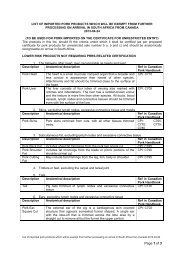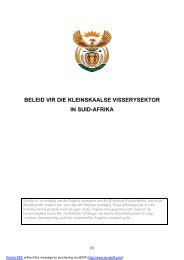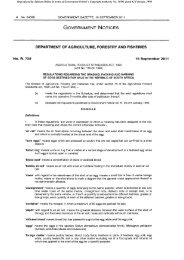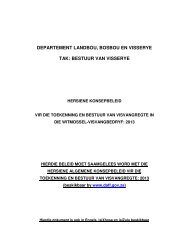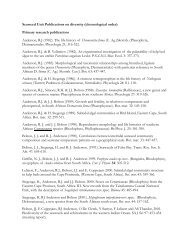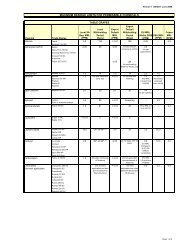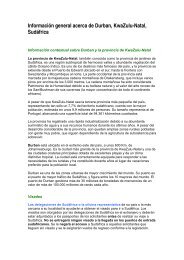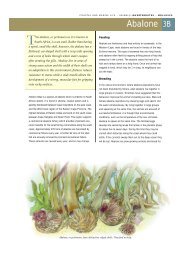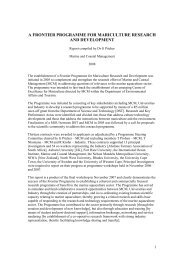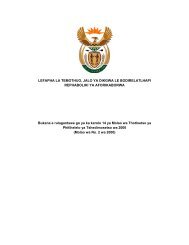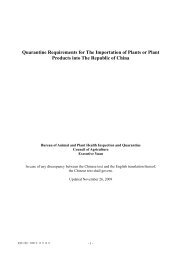Macadamia Nuts Market Value Chain Profile - Department of ...
Macadamia Nuts Market Value Chain Profile - Department of ...
Macadamia Nuts Market Value Chain Profile - Department of ...
You also want an ePaper? Increase the reach of your titles
YUMPU automatically turns print PDFs into web optimized ePapers that Google loves.
A PROFILE OF THE SOUTH AFRICAN MACADAMIA NUTS MARKET VALUE CHAIN<br />
2011<br />
Directorate <strong>Market</strong>ing<br />
Private Bag X15<br />
ARCADIA<br />
0007<br />
Tel: 012 319 8455/6<br />
Fax: 012 319 8131<br />
Email: MorokoloB@daff.gov.za<br />
www.daff.gov.za
TABLE OF CONTENTS<br />
1. DESCRIPTION OF THE INDUSTRY 3<br />
1.1. Employment 3<br />
1.2 Production trends<br />
1.2.1 Production areas<br />
2. MARKET STRUCTURE<br />
2.2 Domestic markets<br />
3. EXPORTS AND IMPORTS<br />
3.1 Exports<br />
3.2 Share analysis<br />
3.3 South Africa <strong>Macadamia</strong> <strong>Nuts</strong> Imports<br />
4. PROCESSING<br />
4.1 <strong>Macadamia</strong> <strong>Value</strong> <strong>Chain</strong> Tree explaining its uses<br />
5. LOGISTICAL ISSUES<br />
5.1 Storage<br />
5.2 Quality<br />
5.3 Shelling<br />
5.4 Drying<br />
5.5 Packaging<br />
6. MARKET INTELLIGENCE<br />
7. MARKET COMPETIVENESS<br />
8. INDUSTRY ORGANIZATION<br />
9. OPPORTUNITIES<br />
10. THREATS<br />
11. OTHER CHALLENGES<br />
12. SAMAC AFFILIATED MACADAMIA MARKETING COMPANIES<br />
ACKNOWLEDGEMENTS<br />
4<br />
4<br />
6<br />
6<br />
7<br />
7<br />
12<br />
14<br />
15<br />
16<br />
18<br />
18<br />
18<br />
18<br />
18<br />
18<br />
20<br />
22<br />
23<br />
23<br />
23<br />
23<br />
24<br />
25<br />
2
1. DESCRIPTION OF THE INDUSTRY<br />
<strong>Macadamia</strong> nuts are quickly becoming an important crop in South Africa and are possibly the<br />
fastest growing tree crop industry in the country. South Africa is the third largest macadamia nut<br />
producer in the world, after Australia (where they originated) and Hawaii (where they were<br />
introduced in the 1880s). The nuts are a valuable food crop with only two <strong>of</strong> the species, M.<br />
integrifolia and M. tetraphylla, being <strong>of</strong> commercial importance. The trees require a hot subtropical<br />
climate without much humidity, in South Africa KwaZulu-Natal, Mpumalanga and Limpopo are ideal<br />
areas. <strong>Macadamia</strong>s are now widely used in the confectionery, baking, ice cream and snack food<br />
industries. <strong>Macadamia</strong> oil's rich, cushiony skin feel and high oxidative stability make it especially<br />
suitable for heavy creams and sun care formulations. Medical research has shown that the<br />
consumption <strong>of</strong> macadamias may significantly lower the risk <strong>of</strong> heart disease.<br />
Source: SAMAC data 2010<br />
Figure 1 above illustrates the contribution <strong>of</strong> the macadamia nuts industry to the gross value <strong>of</strong><br />
agricultural production over a 10 year period. The industry’s contribution increased steadily from<br />
2002 to 2004. In 2005 the industry’s contribution dropped by 26.6% compared to the 2004<br />
production season. This can be attributed to a drop in production volume and market prices in the<br />
same season. From 2006 the industry’s contribution increased steadily reaching a peak in 2008. In<br />
2009, the industry’s contribution decreased by 35% compared to the previous season. This is<br />
attributed to a loss <strong>of</strong> R54 million worth <strong>of</strong> nuts that were lost due to unsound kernels (SAMAC<br />
2009).In 2010, macadamia nuts gross value has decline by 53% compare to gross value in 2009.<br />
This can be attributed to a decline in macadamia prices in the same year.<br />
1.1. Employment<br />
Although most <strong>of</strong> the workforce in the industry is employed seasonally, for the harvesting and<br />
processing from February to August, it is estimated that at least 3000 new job opportunities have<br />
been created on macadamia farms over the last decade and another 1000 jobs in cracking<br />
facilities. In peak season, the industry presently provides employment for more than 4500 farm<br />
3
workers and about 1500 factory workers. Since production is expected to double within the next 5<br />
to 7 years, employment creation will continue to grow at a similar pace.<br />
1.2 Production trends<br />
1.2.1 Production areas<br />
In South Africa, macadamia nuts are mainly grown in three provinces: Limpopo (Tzaneen and<br />
Levubu), Mpumalanga (Barberton, Nelspruit and Hazyview), and on the north and south coast <strong>of</strong><br />
KwaZulu Natal. In the neighboring countries macadamias are produced in Swaziland, Malawi and<br />
Zimbabwe. There are close to 1000 farmers involved in growing macadamia nuts that are supplied<br />
to 12 cracking factories. <strong>Macadamia</strong> nuts are also grown in Brazil, Israel, Thailand, Kenya,<br />
Swaziland, Costa Rica, New Zealand and Guatemala.<br />
Source: SAMAC data, 2010<br />
Figure 2 above shows that in 2010, Mpumalanga province accounted for 8 820 Ha <strong>of</strong> macadamia<br />
nuts, followed by Limpopo with 5 105ha, Kwazulu Natal with 2859 Ha, Eastern Cape with 400 Ha<br />
and the other Provinces amount to 183 Ha. In terms <strong>of</strong> number <strong>of</strong> trees planted, Mpumalanga has<br />
over 2 million, followed by Limpopo with over 1.5 million, Kwazulu Natal with approximately 694<br />
000 and Eastern Cape with 150 000.<br />
4
Source: SAMAC data, 2010<br />
Figure 3 above, illustrates the production <strong>of</strong> macadamia nuts (Dry In Shell -DIS) over a 10 year<br />
period. From 2002 to 2004, production increased steadily and in 2005 there was 17.6% decrease<br />
in total DIS tons compared to previous year. This is attributed to bad weather during flowering and<br />
fruit set in Limpopo Province. From 2006 production increased steadily reaching a peak in 2009. In<br />
2009 season, South Africa produced 24 199 tons DIS macadamia (table 1 below). This is a 13.9%<br />
increase compared to the previous season. In 2010, production <strong>of</strong> dry in shell macadamia nuts<br />
have increased by 12% when compare to 2009 production year. Production growth is a factor <strong>of</strong><br />
tree age, climate and production practices.<br />
Table 1: <strong>Macadamia</strong> processed in South Africa in 2010<br />
Processed<br />
<strong>Macadamia</strong> Limpopo Mpumalanga KZN Total RSA<br />
WIS (kg) 10 759 770 13 256 241 2 248 980 26 264991<br />
DIS (kg) 9 950 260 11 882 663 2 074 160 23 907 083<br />
SK (kg) 2 524 013 3547781 657 500 6 729 294<br />
USK (kg) 544 701 326170 103 044 973 915<br />
TK (tons) 3 068 714 3873951 760 544 7 703 209<br />
SKR% 25.4% 29.9% 31.7% 28.1%<br />
USKR% 5.5% 2.7% 5.0% 4.1%<br />
TKR% 30.8% 32.6% 36.7% 32.2%<br />
Source: SAMAC DATA, 2010<br />
WIS = Wet in shell<br />
DIS = Dry in shell<br />
SK = sound Kernel<br />
USK = Unsound Kernel<br />
5
SKR % = Sound Kernel recovery Percentage<br />
USKR %= Unsound Kernel recovery Percentage<br />
TKR % = Total Kernel recovery Percentage<br />
2. MARKET STRUCTURE<br />
There is no regulation or restriction in the marketing <strong>of</strong> macadamia nuts. The prices <strong>of</strong> macadamia<br />
are determined by market forces <strong>of</strong> demand and supply. The industry is export based with more<br />
than 95% <strong>of</strong> annual production shipped to international markets. USA, Europe and Asia are<br />
presently the largest market for macadamias originating from South Africa. There are close to 1<br />
000 farmers involved in growing macadamia nuts that are supplied to 12 cracking factories. A<br />
number <strong>of</strong> these growers have already achieved GLOBALGAP accreditation and many <strong>of</strong> the<br />
cracking facilities are HACCP and/or ISO 9001 accredited.<br />
2.2 Domestic markets<br />
The main buyers <strong>of</strong> macadamia nuts in South Africa are Spar, Pick 'n Pay and Woolworths.<br />
<strong>Macadamia</strong> nuts are also marketed through national fresh produce markets and directly to<br />
processing companies.<br />
Source: Statistics and Economic Analysis<br />
Figure 4 illustrates the local sales volume <strong>of</strong> macadamia nuts in the markets over a period <strong>of</strong> 10<br />
years. The sales volumes have relatively fluctuated over the years. In 2001, market prices dropped<br />
by 11% due to an increase in macadamia volumes supplied in the market. From 2003 to 2005<br />
macadamia prices increased sharply despite increased volumes. This can be attributed to strong<br />
demand <strong>of</strong> macadamia nuts in the same years. In 2006 the volumes fell by 66% compared to the<br />
previous year and this was accompanied by a 4% decrease in market prices. From 2007 the<br />
6
market prices increased significantly reaching a peak in 2008. In 2009 the market prices dropped<br />
by 37% due to the highest volumes supplied across the markets. In 2010, volumes supplied at the<br />
market increased by 28% which lead to a 33.8% drop in market prices.<br />
3. EXPORTS AND IMPORTS<br />
3.1 Exports<br />
Given the large number <strong>of</strong> young trees yet to come into production, the industry has tremendous<br />
growth and development potential. Over 90% <strong>of</strong> the production (12% <strong>of</strong> world production) is<br />
exported annually. According to ITC -Trade Map, Australia, followed by South Africa, Netherlands,<br />
Kenya, Guatemala and Germany are top countries exporting macadamia nuts.<br />
Source: ITC Trade Map<br />
Figure 5 above, illustrates South Africa macadamia nuts exports destinations in 2010. Hong Kong<br />
with 30% share is South Africa’s largest export market for macadamia nuts, followed by United<br />
States <strong>of</strong> America with 27% and Netherlands, China with 10% share. South Africa also exported<br />
macadamia nuts to Japan, Spain, Viet Nam, United Kingdom and Germany.<br />
7
Source: Quantec Research<br />
* <strong>Macadamia</strong> nuts individual HS code was developed in 2007; it was previously classified in total<br />
nuts code and the available exports data is only for 4 years.<br />
Figure 6 above, shows that in 2008 macadamia nuts exports decreased slightly by 9.8% compared<br />
to 2007 exports. In 2009, the tons exported increased by 31.5% compared to the previous season.<br />
This can be attributed to high production volumes in the same year. It was less pr<strong>of</strong>itable to export<br />
in 2007, since less export values were recorded for high volumes exported. In 2010, the exports<br />
declined by 22.6% despite and in increase in production volumes. It was more pr<strong>of</strong>itable to export<br />
macadamia nuts in 2010, since high value was recorded for less volume exported.<br />
Source: Quantec Research<br />
Figure 7 above indicates that high quantities <strong>of</strong> macadamia nuts were exported to Asia, European<br />
and Americas regions. In 2008, considerable volumes <strong>of</strong> macadamia nuts were exported to the<br />
African region. <strong>Macadamia</strong> nuts export to Oceania was insignificantly low. In 2010, South Africa<br />
8
exported high quantities <strong>of</strong> macadamia nuts to Asian region (Hong Kong, China, Japan and Viet<br />
Nam) followed by Americas (United States <strong>of</strong> America) and European region (Netherlands, Spain,<br />
United Kingdom and Germany).<br />
Source: Quantec Research<br />
Figure 8 above, shows that it was more pr<strong>of</strong>itable to export macadamia nuts to European and<br />
Americas markets. It was less pr<strong>of</strong>itable to export macadamia nuts to Asian countries when<br />
comparing values and the volumes exported to Americas and European countries.<br />
Source: Quantec Research<br />
Figure 9 above illustrate the value <strong>of</strong> macadamia nuts exports from South African Provinces for the<br />
past 4 years. The highlights <strong>of</strong> macadamia nuts were for Mpumalanga, Limpopo and Gauteng<br />
contributed to a lesser extent. The value for Kwazulu Natal macadamia nuts was low despite being<br />
one <strong>of</strong> top province producing macadamia nuts. High value <strong>of</strong> macadamia nuts for Mpumalanga<br />
and Limpopo can be attributed to high production volumes from these provinces and also the<br />
9
cracking factories situated in these provinces. Export value for Gauteng can be attributed to export<br />
agents and export exit point situated in this province. The following figures (Fig. 10 – 14) show the<br />
value <strong>of</strong> macadamia nuts from the various districts in provinces <strong>of</strong> South Africa.<br />
Source: Quantec Research<br />
Figure 10 above shows that macadamia nuts from Western Cape Province were exported through<br />
the City <strong>of</strong> Cape Town. High export values were recorded in 2008. In 2010, there was a significant<br />
increase in macadamia nuts value originating from the City <strong>of</strong> Cape Town when comparing to<br />
2009.<br />
Source: Quantec Research<br />
Figure 11 above shows that macadamia nuts from Kwazulu Natal province were exported from<br />
Ethekwini in 2007 and 2010. Exports from Ugu district were recorded in 2009 and 2010. There<br />
were no values <strong>of</strong> macadamia nuts recorded for Kwazulu Natal in 2008.<br />
10
Source: Quantec Research<br />
Figure 12 above shows that macadamia nuts exports by Gauteng Province were exported through<br />
Ekurhuleni, City <strong>of</strong> Johannesburg and City <strong>of</strong> Tshwane contributed in 2009. The highest export<br />
value was recorded in 2008 from Ekurhuleni district. In 2010, export value for West Rand and City<br />
<strong>of</strong> Tshwane were insignificant, while the export value for Ekurhuleni and City <strong>of</strong> Johannesburg<br />
have considerably increased.<br />
Source: Quantec Research<br />
Figure 13 above shows that macadamia nuts exports by Mpumalanga Province were exported<br />
mainly from Ehlanzeni and Nkangala district municipality. The highest export values were recorded<br />
in 2010 from both Nkangala and Ehlanzeni districts.<br />
11
Source: Quantec Research<br />
Figure 14 above illustrate that the macadamia nuts exports by Limpopo Province were exported<br />
from Vhembe and Mopani districts. The highest export values were recorded in 2009 for both<br />
districts. In 2010, the export value for Vhembe has significantly dropped while the export value for<br />
Mopani district has increased.<br />
3.2 Share analysis<br />
Table 2 below, is an illustration <strong>of</strong> provincial share towards national macadamia nut exports. In<br />
2010, Mpumalanga commanded 76.49%, Limpopo commanded 16.25% and Gauteng commanded<br />
5.58% share <strong>of</strong> macadamia nuts exports. It is interesting that the greatest share <strong>of</strong> export was<br />
commanded by the provinces that have high production volumes which is mostly not a case in<br />
most produce.<br />
Table 2: Share <strong>of</strong> provincial exports to the total RSA macadamia nuts exports (%)<br />
Year<br />
Provinces<br />
2007 2008 2009 2010<br />
Western Cape 0.05 0.27 0 0<br />
Northern Cape 0 0 0.60 0.18<br />
Kwazulu-Natal 0.81 0 1.12 1.40<br />
Gauteng 9.18 9.39 7.35 5.58<br />
Mpumalanga 58.67 47.47 46.29 76.49<br />
Limpopo 31.29 42.87 44.64 16.25<br />
South Africa 100 100 100 100<br />
Source: Calculated from Quantec Research<br />
12
Table 3: Share <strong>of</strong> district exports to the total <strong>of</strong> Gauteng Provincial macadamia nuts exports<br />
(%)<br />
Years<br />
2007 2008 2009 2010<br />
District<br />
West Rand 0.06 0 0 0<br />
Ekurhuleni 21.72 98.60 74.49 72.00<br />
City <strong>of</strong> Johannesburg 78.23 1.40 16.61 28.00<br />
City <strong>of</strong> Tshwane 0 0 8.90 0<br />
Gauteng 100 100 100 100<br />
Source: Calculated from Quantec Research<br />
Table 3 above indicates that Ekurhuleni and City <strong>of</strong> Johannesburg commanded the greatest share<br />
<strong>of</strong> macadamia nuts exports from Gauteng province during the 4 year period. In 2010, Ekurhuleni<br />
has commanded 72% share while City <strong>of</strong> Johannesburg has commanded 28% share <strong>of</strong> Gauteng<br />
macadamia nuts exports.<br />
Table 4: Share <strong>of</strong> district exports to the total <strong>of</strong> Limpopo Provincial macadamia nuts exports<br />
(%)<br />
Year<br />
District<br />
2007 2008 2009 2010<br />
Mopani 74.03 17.71 27.31 66.83<br />
Vhembe 25.97 82.29 72.69 33.17<br />
Limpopo 100 100 100 100<br />
Calculated from Quantec Research<br />
Table 4 illustrates that Vhembe and Mopani commanded the greatest share <strong>of</strong> macadamia nuts<br />
exports from Limpopo Province during the 4 years period. In 2010, Mopani has commanded<br />
66.83% and Vhembe has commanded 33.17% share <strong>of</strong> Limpopo’s macadamia exports. Vhembe<br />
district is one <strong>of</strong> the areas producing high quantities <strong>of</strong> macadamia nuts.<br />
Table 5: Share <strong>of</strong> district exports to the total <strong>of</strong> Mpumalanga Provincial macadamia nuts<br />
exports (%)<br />
Year<br />
District<br />
2007 2008 2009 2010<br />
Nkangala 0 4.31 8.01 45.85<br />
Ehlanzeni 100 95.69 91.99 54.15<br />
Mpumalanga 100 100 100 100<br />
Calculated from Quantec Research<br />
Table 5 above indicates that Ehlanzeni commanded greatest share <strong>of</strong> macadamia nuts exports<br />
from Mpumalanga province during the 4 year period. In 2008 and 2009, share commanded by<br />
Nkangala district municipality was less significant. In 2010 Nkangala has commanded 45.85%<br />
share <strong>of</strong> macadamia nuts from Mpumalanga.<br />
13
3.3 South Africa <strong>Macadamia</strong> <strong>Nuts</strong> Imports<br />
South Africa is not a major macadamia nut importer. This is attributed to high macadamia nuts<br />
production by South Africa. Globally, United States <strong>of</strong> America, Netherlands, Germany, Japan,<br />
China, Luxembourg, Belgium and are top countries importing macadamia nuts.<br />
Source: Quantec Research<br />
* <strong>Macadamia</strong> nuts individual HS code was developed in 2007; it was previously classified in total<br />
nuts code and the available import data is only for 3 years.<br />
Figure 15 above, illustrate South Africa macadamia nuts imports for the past 4 years. In 2008,<br />
there was a 9.5% increase in macadamia nuts imports while in 2009 the imports decreased by<br />
21%. The decline in imports in 2009 can be attributed to high domestic production in the same<br />
year. In 2007 and 2008 it was cheaper to imports since lower values where recorded for higher<br />
volumes imported. South Africa <strong>Macadamia</strong> nuts imports have declined by 10.6% when compared<br />
to 2009. In 2010, it was also expensive to import macadamia nuts as high values were recorded for<br />
lower volumes imported.<br />
14
Source: Quantec Research<br />
Figure 16 above illustrate the regions supplying South Africa with macadamia nuts. South Africa<br />
imports high volumes <strong>of</strong> macadamia nuts from African countries (Malawi and Zimbabwe). A fraction<br />
<strong>of</strong> macadamia nuts was imported from Asia (Japan) <strong>Macadamia</strong> nuts from Europe were recorded<br />
in 2007 and 2010. In 2010, South Africa imported considerable volumes <strong>of</strong> macadamia nuts from<br />
Oceania region (Australia).<br />
Source: Quantec Research<br />
Figure 17 above shows high imports value for the African region due to high volumes imported<br />
from that region. In 2010, it was more expensive to import macadamia nuts from Oceania, since<br />
high import value was recorded for less volume imported.<br />
4. PROCESSING<br />
15
The kernel is the main product from the macadamia nut tree. After harvesting, the husks covering<br />
the nuts are removed. The nuts are fried, the shells are cracked, and the kernels are removed to<br />
be oil-roasted or dry-roasted. Kernels are commonly sold as snack nuts and chocolate-covered<br />
candy. Ice cream manufacturers and the baking industry also use macadamia kernels as an<br />
ingredient. The shell and husk also have uses. Shells can be used as mulch, fuel for processing<br />
macadamia nuts, planting medium for anthurium culture, plastic manufacture and as a substitute<br />
for sand in the sand-blasting process. Husks are used as mulch or composted for fertilizer. Oil can<br />
be extracted from culled nuts. The cosmetic industry, especially in Japan, uses the oil in soaps,<br />
sunscreens and shampoos. The remaining press cake might be used for animal feed.<br />
4. 1 <strong>Macadamia</strong> <strong>Value</strong> <strong>Chain</strong> Tree explaining its uses<br />
Shell/ husk<br />
Fuel<br />
Fertilizer<br />
Mulch<br />
<strong>Macadamia</strong> nuts<br />
Kernel<br />
<strong>Macadamia</strong> oil<br />
Cosmetic Industry<br />
Soap, Sunscreen and<br />
Shampoo<br />
<strong>Macadamia</strong><br />
Butter<br />
Roasted / fried<br />
kernel, Snacks<br />
Baking ingredient<br />
Salad oil<br />
Animal feed<br />
16
Figure 18: <strong>Market</strong> value chains for <strong>Macadamia</strong> nuts<br />
Input Suppliers<br />
Research<br />
Imports<br />
Farmers/Producers<br />
SAMAC<br />
Processing<br />
factories/cracking factory<br />
Drying<br />
Cracking (dehusking)<br />
Sorting/cooking/<br />
Roasting<br />
Final grading and<br />
Packaging<br />
Fresh produce <strong>Market</strong>s,<br />
Wholesalers, Supermarkets,<br />
Retailers and Informal<br />
Consumers<br />
Exports<br />
<strong>Macadamia</strong> value chain can be broken down into the following levels: the producer <strong>of</strong> macadamia<br />
nuts (farmers), Processing /cracking factory owner (who dry, crack (dehusk), sort, cook, roast, grade,<br />
package, store and distribute macadamia nuts). Processing factories also market and sell<br />
macadamia nuts to fresh produce markets, wholesalers, supermarkets, retailers and informal<br />
markets and then to end users (consumers).<br />
17
5. LOGISTICAL ISSUES<br />
5.1 Storage<br />
Vacuum packed raw macadamia kernel should be stored in a cool (15°C to 25°C), dry and well<br />
ventilated area. Stored under these conditions, raw macadamia kernel which conformed to all the<br />
quality specifications at packing, will maintain this quality for 16 to 18 months without any serious<br />
quality deterioration. This length <strong>of</strong> time <strong>of</strong> quality preservation is <strong>of</strong> course only achieved if the<br />
correct vacuum pouch material, with the oxygen and water vapour transmission rate properties as<br />
described below is used:-<br />
5.2 Quality<br />
Minimum quality standards for South African macadamias were first agreed to and implemented by<br />
marketers in 1994. These covered the main quality parameters affecting kernel rancidity (free fatty<br />
acids and peroxide value), hygiene (Coliforms and E.Coli) and moisture level (moisture content %).<br />
These minimum quality standards have now been extended to include additional quality<br />
parameters, providing a more comprehensive definition <strong>of</strong> quality specifications in line with<br />
international trends.<br />
5.3 Shelling<br />
For successful shelling, the nuts should be dried to a moisture content <strong>of</strong> about 1, 5 % to ensure<br />
that kernels shrink away from the shells. Therefore, nuts should be dried before shelling. The final<br />
drying takes place in large containers through which hot air is circulated. The macadamia nut has a<br />
very hard shell, but is easily cracked mechanically between rotating steel rollers. A nutcracker or<br />
shelling machine works on the principle that nuts are cracked between a rotating steel roller and a<br />
fixed plate. The distance between the roller and the plate is adjustable according to the grading<br />
size <strong>of</strong> the nuts. The kernels <strong>of</strong> the nuts that have been properly dried drop from the shells when<br />
the nuts are cracked.<br />
5.4 Drying<br />
Freshly harvested, dehusked nuts contain 25% moisture and must be dried before they are stored<br />
in bulk. Wire frames containing 3 layers <strong>of</strong> nuts are used for drying. Air must circulate freely<br />
between the frames to prevent mould. A fan may be used. The nuts could also be sundried, but if<br />
the freshly harvested nuts are exposed to the sun immediately, the shells may crack. These cracks<br />
provide access to insects when the nuts are stored. If the nuts are not dried, but immediately<br />
stored in bags or other containers, fungal growth could occur.<br />
5.5 Packaging<br />
Packaging also plays a vital role in ensuring safe and efficient transport <strong>of</strong> a product and<br />
conforming to handling requirements, uniformity, recyclable materials specifications, phytosanitary<br />
requirements, proper storage needs and even attractiveness (for marketing purposes).<strong>Macadamia</strong><br />
stored in its original, unopened package in a cool, dry environment, it will normally retain that<br />
18
quality for at least a year from its package date. For longer shelf life, the product should be stored<br />
under cold storage with low relative humidity. <strong>Macadamia</strong> kernels can easily deteriorate during<br />
handling and repackaging unless certain principles are kept in mind. Unlike other edible nuts, the<br />
macadamia kernel requires a storage environment, which is very low in moisture and oxygen. This<br />
is best achieved by a combination <strong>of</strong> gas flushing with food grade carbon dioxide or nitrogen, and<br />
partial vacuuming before hermetically sealing the pouch. Only then will a satisfactory shelf life be<br />
attained.<br />
The partial vacuum also helps to stop the kernels rubbing during transit and to prevent puncturing<br />
<strong>of</strong> the protective film. Once the package is opened and the kernels are exposed to the atmosphere<br />
for several hours they will absorb moisture and begin to lose their "crunch". Even an increase in<br />
moisture from 1.5% to 1.8% makes a significant difference to the texture. If stored open to the air<br />
the kernel moisture will continue to rise and the eating quality will decrease markedly. If stored<br />
under these conditions at room temperature for several weeks their taste will change as rancidity<br />
slowly develops. Deterioration may also occur if kernel is packaged in poor quality packaging<br />
materials e.g. Polythene or cellophane bags. The shelf life <strong>of</strong> kernel packed under these conditions<br />
may be considerably less than a month before there is a discernible loss <strong>of</strong> eating quality. The fried<br />
or roasted nuts are packed in airtight bottles, tins or plastic containers for consignment and<br />
marketing.<br />
19
6. MARKET INTELLIGENCE<br />
Table 6: Tariffs applied by various exports markets for macadamia nuts originating from South Africa.<br />
Country (2010) Product description ( H0802600)<br />
Canada<br />
<strong>Macadamia</strong> nuts, fresh or dried, whether<br />
or not shelled or peeled<br />
China<br />
<strong>Macadamia</strong> nuts, fresh or dried, whether<br />
or not shelled or peeled<br />
Belgium<br />
<strong>Macadamia</strong> nuts, fresh or dried, whether<br />
or not shelled or peeled<br />
France<br />
<strong>Macadamia</strong> nuts, fresh or dried, whether<br />
or not shelled or peeled<br />
Germany<br />
<strong>Macadamia</strong> nuts, fresh or dried, whether<br />
or not shelled or peeled<br />
Congo<br />
<strong>Macadamia</strong> nuts, fresh or dried, whether<br />
or not shelled or peeled<br />
Hong Kong<br />
<strong>Macadamia</strong> nuts, fresh or dried, whether<br />
or not shelled or peeled<br />
Japan<br />
Luxembourg<br />
Kenya<br />
Trade regime<br />
description Applied tariff<br />
MFN duties (Applied) 0.00% 0.00%<br />
MFN duties (Applied) 0.00% 0.00%<br />
Preferential tariff for<br />
South Africa<br />
Preferential tariff for<br />
South Africa<br />
Preferential tariff for<br />
South Africa<br />
0.00% 0.00%<br />
0.00% 0.00%<br />
0.00% 0.00%<br />
MFN duties (Applied) 30.00% 30.00%<br />
MFN duties (Applied) 0.00% 0.00%<br />
Estimated total<br />
ad valorem<br />
equivalent<br />
tariff<br />
<strong>Macadamia</strong> nuts, fresh or dried, whether<br />
MFN duties (Applied) 5.00% 5.00%<br />
or not shelled or peeled Preferential tariff for<br />
GSP countries<br />
2.50% 2.50%<br />
<strong>Macadamia</strong> nuts, fresh or dried, whether<br />
or not shelled or peeled<br />
Preferential tariff for<br />
South Africa<br />
0.00% 0.00%<br />
<strong>Macadamia</strong> nuts, fresh or dried, whether<br />
or not shelled or peeled<br />
MFN duties (Applied) 25.00% 25.00%<br />
20
Country (2010) Product description ( H0802600)<br />
Malawi<br />
<strong>Macadamia</strong> nuts, fresh or dried, whether<br />
or not shelled or peeled<br />
Netherlands<br />
<strong>Macadamia</strong> nuts, fresh or dried, whether<br />
or not shelled or peeled<br />
Spain<br />
<strong>Macadamia</strong> nuts, fresh or dried, whether<br />
or not shelled or peeled<br />
United Kingdom<br />
<strong>Macadamia</strong> nuts, fresh or dried, whether<br />
or not shelled or peeled<br />
United States <strong>of</strong> <strong>Macadamia</strong> nuts, fresh or dried, whether<br />
America or not shelled or peeled<br />
Zimbabwe<br />
<strong>Macadamia</strong> nuts, fresh or dried, whether<br />
or not shelled or peeled<br />
Source: <strong>Market</strong> Access Map<br />
Trade regime<br />
Estimated total<br />
ad valorem<br />
equivalent<br />
description Applied tariff tariff<br />
Preferential tariff for<br />
South Africa<br />
10.00% 10.00%<br />
Preferential tariff for<br />
South Africa<br />
0.00% 0.00%<br />
Preferential tariff for<br />
South Africa<br />
0.00% 0.00%<br />
Preferential tariff for<br />
South Africa<br />
0.00% 0.00%<br />
MFN duties (Applied) 13.00$/ton 0.21%<br />
MFN duties (Applied) 40.00% 40.00%<br />
The lucrative exports markets for macadamia nut are in European countries (France, Belgium, Germany, Netherlands, and United Kingdom) since<br />
they countries apply 0.00% preferential tariff to macadamia nut originating from South Africa due to EU-SA Free Trade Agreement (FTA). China,<br />
Canada and Hong Kong also apply 0.00% tariff. African markets in Kenya, Malawi and Zimbabwe are protected by 25%, 10% and 40% tariffs<br />
respectively in spite <strong>of</strong> the existence <strong>of</strong> the SADC-FTA. Zimbabwe is one <strong>of</strong> the countries producing macadamia; high tariff can be a measure to<br />
protect domestic producers.<br />
21
7. MARKET COMPETIVENESS<br />
Figure 19<br />
Source: ITC Trade Map<br />
Figure 19 above shows that United States <strong>of</strong> America and Netherlands are the biggest exports<br />
market for macadamia nuts from South Africa. In 2008 there was a decline in export value earned<br />
from Netherlands. The exports value earned from Japan, Spain and United Kingdom have also<br />
increased during the period under review. In 2008, there was a decline in value <strong>of</strong> macadamia nuts<br />
exported to Germany. In 2010, export value earned from United States <strong>of</strong> America, Netherlands<br />
and China has increased significantly compared to 2009 export value.<br />
22
8. INDUSTRY ORGANIZATION<br />
The macadamia nuts industry is formally organized to The Southern African <strong>Macadamia</strong> Growers’<br />
Association (SAMAC). The association is comprised <strong>of</strong> macadamia nut growers, processors and<br />
marketers. The Association is funded by its grower members who pay a production levy, which is<br />
collected by the processors. SAMAC uses the funds collected to finance research and the<br />
dissemination <strong>of</strong> research results to growers, processors and marketers.<br />
9. OPPORTUNITIES<br />
The volume <strong>of</strong> macadamia nuts exported has grown tremendously over the past few years and is<br />
expected to increase in the future. South Africa is tapping in new markets in China and Hong Kong.<br />
A number <strong>of</strong> major growers have already received accreditation for Global Gap and the rest <strong>of</strong> the<br />
industry is aware <strong>of</strong> the need to follow fast in their footsteps. Every effort is being made by the<br />
industry to keep pace with, or even ahead <strong>of</strong> international demands in terms <strong>of</strong> quality standards,<br />
including the judicious use <strong>of</strong> chemicals at farm level. The South African industry target was set for<br />
95% Global Gap accreditation at farm level in 2004. Most South African processors are<br />
HACCP/ISO accredited.<br />
10. THREATS<br />
The macadamia industry suffers a high incidence <strong>of</strong> local and organized theft. Factors’ influencing<br />
unsound kernel percentage in South Africa is stink bug damage, kernel discolorations and kernel<br />
immaturity. The stink bug damage is prevalent. Factors that affect nut quality have to be addressed<br />
on continual basis. The integrated pest management is still the most responsible, efficient and cost<br />
effective way to control damage caused by these insects.<br />
11. OTHER CHALLENGES<br />
South African macadamia industry indicates that land claims are one <strong>of</strong> their major issue that raise<br />
uncertainties for farmers. Land, as a political and social issue, dates back from the Native Land Act<br />
<strong>of</strong> 1913, which dispossessed blacks and exploited their social domination to the land. The current<br />
government <strong>of</strong> the Republic <strong>of</strong> South Africa imposed an obligation to land reform by facilitating<br />
restorative land justice, increasing access to land and improving tenure security. These pose<br />
challenges to farmers in terms <strong>of</strong> investing on the land.<br />
23
12. SAMAC AFFILIATED MACADAMIA MARKETING COMPANIES<br />
Company Contact Person Tel email<br />
Golden <strong>Macadamia</strong>s Allen Duncan +27 13 733 5034 allen@goldenmacadamias.com<br />
Green Farms Nut<br />
Company<br />
Jill Whyte +27 15 516 4710 whytespr@mweb.co.za<br />
Ivory <strong>Macadamia</strong>s Walter Giuricich +27 82 967 6757 ivorymacs@mweb.co.za<br />
Maclands Estate Percy Anderson +27 15 556 7700 percya@mweb.co.za<br />
Mayo Macs <strong>Macadamia</strong>s PJ Venter +27 13 733 4600 pj@mayoestate.co.za<br />
Emvest <strong>Nuts</strong> Chris Davidson +27 12 482 6802 chris.davidson@emvest.com<br />
Royal <strong>Macadamia</strong> Bruce Milton +27 15 583 0395 rm@royalmacadamia.co.za<br />
Sage Foods Christian Mailey +27 82 227 4674 christian@sagefoods.co.za<br />
Tzamac Keith Baragwanath +27 83 626 9564 keith@baraprops.co<br />
24
ACKNOWLEDGEMENTS<br />
The following organizations are acknowledged:<br />
National <strong>Department</strong> <strong>of</strong> Agriculture, Forestry and Fisheries<br />
Directorate: Statistics and Economic Analysis<br />
Private Bag X246<br />
Pretoria<br />
0001<br />
Tel (012) 930 1134<br />
Fax (012) 319 8031<br />
Trade and Industrial Policy Strategies (TIPS)<br />
P.O. Box 11214<br />
Hatfield<br />
0028<br />
Tel (012) 431 7900<br />
Fax (012) 431 7910<br />
SAMAC (South African <strong>Macadamia</strong> Growers’ Association)<br />
www.samac.org.za<br />
Quantec Research<br />
www. quantec.co.za<br />
<strong>Market</strong> Access Map<br />
www.macmap.org<br />
Economic Research Service/USDA<br />
www.wikipedia.co.za<br />
Disclaimer: This document and its contents have been compiled by the <strong>Department</strong> <strong>of</strong> Agriculture,<br />
Forestry and Fisheries for the purpose <strong>of</strong> detailing the macadamia nuts industry. Anyone who uses<br />
this information does so at his/her own risk. The views expresses in this document are those <strong>of</strong> the<br />
<strong>Department</strong> <strong>of</strong> Agriculture, Forestry and Fisheries with regard to macadamia nuts industry, unless<br />
otherwise stated. The <strong>Department</strong> <strong>of</strong> Agriculture, Forestry and Fisheries accepts no liability that<br />
can be incurred resulting from the use <strong>of</strong> this information<br />
25





